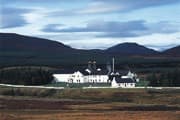La distillerie Dalwhinnie

When you arrive from the A9, a spectacular Scottish road, over the top of the Drumochter Pass, which is often covered in snow in the winter, the Dalwhinnie distillery can be seen on the plateau just below. Even in the summer, temperatures at the highest active distillery in Scotland (around 300m) remain cool, so it’s easy to imagine how tough the winters get here. At one time (and perhaps still now) beds were even available in the distillery for workers stranded on stormy days when the snow had piled up many meters high.
And the dramatic silhouettes of the surrounding mountains make it easy to imagine the relief of the drovers who, coming from Perth and Inverness, stumbled upon Dalwhinnie (the Gaelic word means “meeting place”) and were reinvigorated by a couple of “uisge beatha” from an illicit still. Might Bonnie Prince Charles have enjoyed the same dram when he attempted to reach Skye from Rannoch Moor near Dalwhinnie on the day after defeat at Culloden, as he was pursued by his cousin who had put a price on his head?

The area sees record cold temperatures throughout the year. In fact, the spring used by Dalwhinnie is fed by melted snow and is always freezing cold, in summer and winter alike. Brochures about Dalwhinnie never fail to mention this special feature, citing it as the source of the single malt’s unctuous, honey-sweet character.
The malt’s smooth heather aromas are also reflected in the landscape, on the pink peaks of the mountains that surround the distillery. There is a dryness in the finish that is unique to single malts from the Highlands.
Like Cragganmore in Speyside, it was its promotion in 1988 in the Classic Malts range, representing malts from the north Highlands, that led to Dalwhinnie emerging from the shadows.